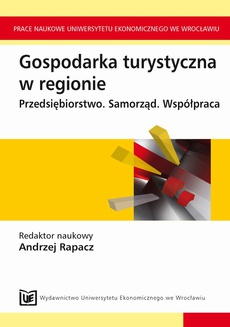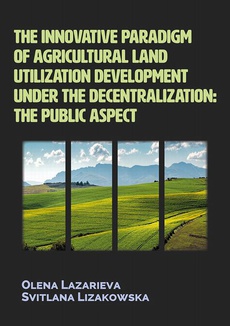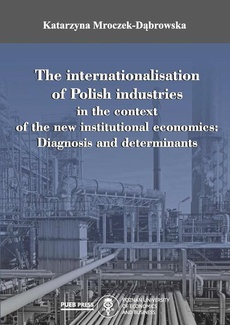POLECAMY

The Impact of Economic Actors' Decision-making on Socio-economic Development
Redakcja:
Format:
ibuk
The level of socio-economic development is determined by many factors, and the monography considers the microfoundations of this order. The increase of the economic activity is an important condition to achieve social welfare and reduce inequalities. And constant improvement of living conditions of present and future generations is possible by keeping right balance between three kinds of capital: economic, human, and natural. The economic policy is a feature of great importance for decisions taken by business entities. The most important goal is a general economic growth, which is to serve the society, and improve the life quality. These are current challenges of open, free market economy, and globalization and liberalization of economic relations.
| Rok wydania | 2020 |
|---|---|
| Liczba stron | 102 |
| Kategoria | Inne |
| Wydawca | Wydawnictwo Uniwersytetu Ekonomicznego we Wrocławiu |
| ISBN-13 | 978-83-7695-810-1 |
| Numer wydania | 1 |
| Język publikacji | angielski |
| Informacja o sprzedawcy | ePWN sp. z o.o. |
Ciekawe propozycje
Spis treści
| Introduction | 9 |
| 1. Conditions for economic development in the light of the progress of globalisation (Michał Bilczak) | 11 |
| 1.1. Main points and transformations of globalization | 11 |
| 1.2. Adverse globalisation processes | 16 |
| References | 19 |
| 2. The differentiation of the socio-economic development in Poland – A regional approach (Marcin Spychała) | 19 |
| 2.1. The core as well as the factors of the socio-economic development | 19 |
| 2.2. The research procedure | 20 |
| 2.3. The conclusions of the research procedure conducted concerning the respective factors of development | 26 |
| 2.4. The conclusions from the research analysis concerning the general socio-economic level of districts | 29 |
| References | 30 |
| 3. Stakeholders in the light of Corporate Social Responsibility (Anna Krzysztofek) 31 | |
| 3.1. Introduction | 31 |
| 3.2. Stakeholder theory | 31 |
| 3.3. Corporate Social Responsibility | 33 |
| 3.4. Stakeholder theory and the concept of Corporate Social Responsibility | 35 |
| 3.5. Final remarks | 38 |
| References | 39 |
| 4. Social cooperatives and their role in the inclusion of people with disabilities (Andrzej Koza) | 42 |
| 4.1. People with disabilities as the subpopulation at risk of unemployment and social exclusion | 42 |
| 4.2. The role of employment in the inclusion process of people with disabilities | 44 |
| 4.3. Social cooperatives as workplaces and integration forms of persons with disabilities | 45 |
| References | 49 |
| 5. Senior Entrepreneurship (SE) – An attempt to assess the potential and to recommend the preliminary model supporting the development of SE in Poland (Beata Bieńkowska) | 51 |
| 5.1. Does Senior Entrepreneurship matter? | 51 |
| 5.2. Senior Entrepreneurship – Definition of the concept and short literature review | 53 |
| 5.3. Characteristics of the 60+ group | 55 |
| 5.4. Main support programs for active ageing | 59 |
| 5.5. Recommendation of an inclusive model of support for the development of SE | 60 |
| 5.6. Final remarks | 63 |
| References | 64 |
| 6. Environmental education and ecological awareness – Polish experience (Bartosz Bartniczak, Andrzej Raszkowski) 68 | |
| 6.1. The concept of environmental education | 68 |
| 6.2. Environmental education in Polish strategic documents | 70 |
| 6.3. The situation of environmental education in Poland | 72 |
| 6.4. Conclusions | 78 |
| References | 79 |
| 7. The new European systemic approach to non-performing loans (Jan Koleśnik) | 82 |
| 7.1. The problem of non-performing loans in the European banking system | 82 |
| 7.2. NPL vs. exposures in default | 84 |
| 7.3. NPL in capital adequacy calculation | 85 |
| 7.4. Secondary markets for NPLs | 87 |
| 7.5. Evaluation of a new European systemic approach to NPLs | 88 |
| 7.6. Long-term effects of a new European systemic approach to NPLs | 89 |
| References | 90 |
| 8. The project of the integrative currency area. The case of chosen Central and Eastern European countries (Marcin Jędrzejczyk) 91 | |
| 8.1. Introduction | 91 |
| 8.2. The critical analysis of the optimum currency areas in the context of the Eurozone | 92 |
| 8.3. Wage productivity parity and its role in the creation of the integrative currency area | 94 |
| 8.4. The quantitative formula for the creation of the integrative currency area on the basis of three-seas-initiative countries | 95 |
| 8.5. Final remarks | 99 |
| References | 100 |
| Summary | 101 |
























